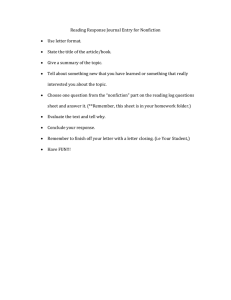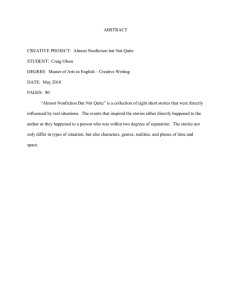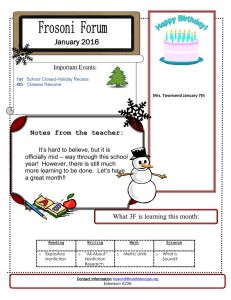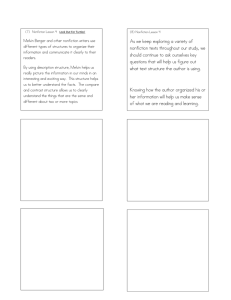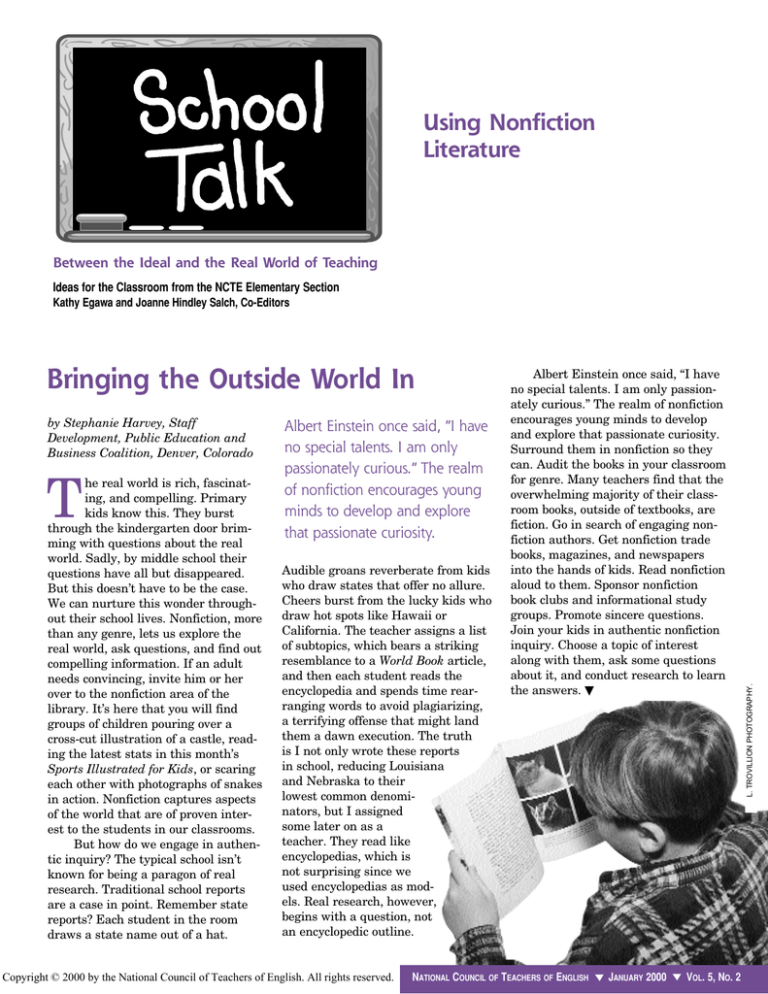
Using Nonfiction
Literature
Between the Ideal and the Real World of Teaching
Ideas for the Classroom from the NCTE Elementary Section
Bringing the Outside World In
by Stephanie Harvey, Staff
Development, Public Education and
Business Coalition, Denver, Colorado
T
he real world is rich, fascinating, and compelling. Primary
kids know this. They burst
through the kindergarten door brimming with questions about the real
world. Sadly, by middle school their
questions have all but disappeared.
But this doesn’t have to be the case.
We can nurture this wonder throughout their school lives. Nonfiction, more
than any genre, lets us explore the
real world, ask questions, and find out
compelling information. If an adult
needs convincing, invite him or her
over to the nonfiction area of the
library. It’s here that you will find
groups of children pouring over a
cross-cut illustration of a castle, reading the latest stats in this month’s
Sports Illustrated for Kids, or scaring
each other with photographs of snakes
in action. Nonfiction captures aspects
of the world that are of proven interest to the students in our classrooms.
But how do we engage in authentic inquiry? The typical school isn’t
known for being a paragon of real
research. Traditional school reports
are a case in point. Remember state
reports? Each student in the room
draws a state name out of a hat.
Albert Einstein once said, “I have
no special talents. I am only
passionately curious.” The realm
of nonfiction encourages young
minds to develop and explore
that passionate curiosity.
Audible groans reverberate from kids
who draw states that offer no allure.
Cheers burst from the lucky kids who
draw hot spots like Hawaii or
California. The teacher assigns a list
of subtopics, which bears a striking
resemblance to a World Book article,
and then each student reads the
encyclopedia and spends time rearranging words to avoid plagiarizing,
a terrifying offense that might land
them a dawn execution. The truth
is I not only wrote these reports
in school, reducing Louisiana
and Nebraska to their
lowest common denominators, but I assigned
some later on as a
teacher. They read like
encyclopedias, which is
not surprising since we
used encyclopedias as models. Real research, however,
begins with a question, not
an encyclopedic outline.
Copyright © 2000 by the National Council of Teachers of English. All rights reserved.
Albert Einstein once said, “I have
no special talents. I am only passionately curious.” The realm of nonfiction
encourages young minds to develop
and explore that passionate curiosity.
Surround them in nonfiction so they
can. Audit the books in your classroom
for genre. Many teachers find that the
overwhelming majority of their classroom books, outside of textbooks, are
fiction. Go in search of engaging nonfiction authors. Get nonfiction trade
books, magazines, and newspapers
into the hands of kids. Read nonfiction
aloud to them. Sponsor nonfiction
book clubs and informational study
groups. Promote sincere questions.
Join your kids in authentic nonfiction
inquiry. Choose a topic of interest
along with them, ask some questions
about it, and conduct research to learn
the answers. ▼
NATIONAL COUNCIL OF TEACHERS OF ENGLISH
JANUARY 2000
VOL. 5, NO. 2
L. TROVILLION PHOTOGRAPHY.
Kathy Egawa and Joanne Hindley Salch, Co-Editors
L. TROVILLION PHOTOGRAPHY.
An Alternate Study of the U.S.
The following bibliography is part of
the list from the Different Ways of
Knowing curriculum module A
Geography Journey: Adventuring in
the U.S. (Galef Institute, 1996).
It gives readers another option for
how one might conceptualize a study
of the United States beyond state
reports. As with many text sets, both
fiction and nonfiction titles are
included.
Rethinking the Use of Nonfiction
by Kathy Egawa and Joanne Hindley Salch, co-editors
I
t pleases us to reconsider the role
of nonfiction in this issue of
School Talk. As elementary educators who were once challenged to
give nonfiction more than a minor
role in our literacy curriculum, we
began using nonfiction more consciously a number of years ago. Like
many of our colleagues, we have
included nonfiction in genre studies,
created text sets focused on units of
study children clamor for (e.g., reptiles, bats, Egyptian life), and even
helped develop students’ abilities to
navigate the nonfiction selections on
standardized reading tests. Yet we
laugh in recognition of the constrained “state report” assignment
that Stephanie sketched out in the
introduction—an assignment that is
still being given in many variations.
So for this issue, we went in
search of teacher stories that could
further push our collective understanding. In what other ways are
teachers seamlessly using nonfiction
in their curriculum? What text sets
have they pulled together? And how
are the students responding?
John Dewey noted years ago that
learning coalesces in the library—a
place where children can bring their
experiences, problems, questions, and
the particular facts they have found
and discuss them so that new light
may be thrown upon them, particularly new light from the experience of
others. He offers that this is “the
organic relation of theory and practice; the child not simply doing
things, but getting also the idea of
what he does. Harmful as a substitute
for experience, reading is all-important in interpreting and expanding
experience” (1900, p. 85).
You’ll see Dewey’s ideas in action
here. Both of our teacher stories illustrate the ways students have used
nonfiction to think about their interactions with the world around
them—Vivian Vasquez’s four-yearolds as they consider the effect of
pollution on whales, and Monica
Edinger’s fourth graders’ study of
immigration. We offer a text set bibliography from a unit of study in
Different Ways of Knowing, a comprehensive school reform initiative of
the Galef Institute, a nonprofit organization that provides teaching
strategies to integrate history and
social studies with the arts and math
and science. Finally, we include a list
of award-winning nonfiction. We
hope that browsing this list might
serve as a springboard for shaping
your own curriculum studies! ▼
Children’s Atlas of the United States
(Rand McNally), 1992
Coral Reef by Barbara Taylor (Dorling
Kindersley), 1992
Crinkleroot’s Guide to Walking in Wild
Places by Jim Arnosky (Bradbury
Press), 1990
Desert Giant: The World of the Saguaro
Cactus by Barbara Bash (Sierra Club
Books/Little, Brown), 1989
Forest Life by Barbara Taylor (Dorling
Kindersley), 1992
Geography from A to Z: A Picture
Glossary by Jack Knowlton
(HarperCollins), 1988
The Gift of the Tree by Alvin Tresselt
(Lothrop, Lee & Shepard), 1992
High in the Mountains by Ruth Yaffe
Radin (Macmillan), 1989
Life in the Deserts by Lucy Baker
(Scholastic), 1990
Life in the Oceans by Lucy Baker
(Scholastic), 1990
Pond Life by Barbara Taylor (Dorling
Kindersley), 1992
Ranger Rick’s Nature Scope by Judy
Braus, Editor (National Wildlife
Federation), 1985
Signs Along the River: Learning to Read
the Natural Landscape by Kayo
Robertson (Roberts Rinehart), 1986
Stringbean’s Trip to the Shining Sea by
Vera B. Williams and Jennifer
Williams (Greenwillow Books), 1988
Trees and Leaves by Althea Braithwaite
(Troll Associates), 1990
Mountains and Volcanoes by Barbara
Taylor (Kingfisher Books), 1993
Rivers and Oceans by Barbara Taylor
(Kingfisher Books), 1993
For more information,
contact the Galef Institute at
www.dwoknet.galef.org or telephone
310-479-8883. ▼
TeacherStories TeacherStories TeacherStories TeacherStories Teach
Getting beyond
“I like the book”:
Putting a Critical Edge on Kids’
Purposes for Reading
by Vivian Vasquez, American
University, Washington, D.C.
D
uring class meeting time, in a
room I shared with 16
preschool-aged children, fouryear-old Lily talked about a news segment she had seen on television the
night before. She had watched a
report on the pollution in the St.
Lawrence River, located in southeastern Canada. The pollution was caused
by chemical waste dumped into the
water by a manufacturing company
on the shore of the river. From the
news, Lily learned that Beluga
whales live in the river and have
therefore suffered the consequences of
absorbing chemical waste into their
bodies. Given this new knowledge, I
decided to revisit a text we had read
previously about Beluga whales.
In this teacher story I will share
some of the conversations that we had
regarding the book Baby Beluga by
Raffi (1990) and how we moved our
conversations beyond statements such
as “I like the book because . . .” or “My
favorite part is . . .” toward using nonfiction resource books to question the
way that Beluga whales are portrayed
in books such as Baby Beluga.
What We Did
Prior to reading Baby Beluga we
generated a list of words that
described the whales that Lily had
talked about during class meeting.
Using a text set composed of various
nonfiction resource books on Beluga
whales, we came up with the following list:
in danger
not safe
need help
sick
dying
no power
hurt
hungry
scared
almost extinct
After reading Raffi’s book we created a second list of words to describe the
whales in the song/book:
free
happy
snug
safe
fun life
singing happy
on the go
playing
comfortable
splashing around for fun
We looked at both sets of words to
consider how the whales are portrayed
differently in the song/book, by the nonfiction books we had read, and by the
television news program. One of the
children asked, “What is real?” This
question helped me to realize that “for
at least some of the children the boundaries between life in books and life as
they understand it are blurred” (O’Brien
1998, p.10). In response we talked about
how different texts offer different perspectives of the world. We also talked about
how important it is to think about other
ways that a text could be written or presented. I felt that this rewriting of text
could be a way to get past seeing the book
as the way life really is for the Beluga
whales. In doing so we are engaging in
the construction of different meanings.
The children talked about how they
liked singing the song, but that the song
“doesn’t give us a good idea of what is
happening with the whales in the river
[St. Lawrence].” As a result of the readaloud, we engaged in rewriting the song.
continued on page 4
The Orbis Pictus Award
Each year, the winners of NCTE’s
Orbis Pictus Award for Outstanding
Nonfiction for Children are selected
from among many titles. The
Orbis Pictus Committee, currently
co-chaired by Karen Patricia Smith
and Richard M. Kerper, formally
announces the winner at the Books
for Children Luncheon, held each
year at NCTE’s annual convention.
Here are the winners and honor
books for the last six years—sure
bets for your nonfiction library.
1999 Shipwreck at the Bottom of
the World: The Extraordinary True
Story of Shackleton and the
Endurance, Jennifer Armstrong
(Crown); Honor Books: Black
Whiteness: Admiral Byrd Alone in
the Antarctic, Robert Burleigh, illustrated by Walter Lyon Krudop
(Atheneum); Fossil Feud: The Rivalry
of the First American Dinosaur
Hunters, Thom Holmes (Messner);
Hottest, Coldest, Highest, Deepest, Steve
Jenkins (Houghton); No Pretty Pictures:
A Child of War, Anita Lobel
(Greenwillow)
1998 An Extraordinary Life: The
Story of a Monarch Butterfly, Laurence
Pringle, paintings by Bob Marstall
(Orchard Books); Honor Books: A
Drop of Water: A Book of Science and
Wonder, Walter Wick (Scholastic); A
Tree Is Growing, Arthur Dorros, illustrated by S.D Schindler (Scholastic);
Charles A. Lindbergh: A Human Hero,
James Cross Giblin (Clarion); Kennedy
Assassinated! The World Mourns: A
Reporter’s Story, Wilborn Hampton
(Candlewick); and Digger: The Tragic
Fate of the California Indians from the
Missions to the Gold Rush, Jerry
Stanley (Crown)
continued on page 4
Stories TeacherStories TeacherStories TeacherStories TeacherStories
© SUSAN LINA RUGGLES. USED BY PERMISSION.
continued from page 3
(See Figure 1.) We decided to send the
money from our classroom store (where
we sold cereal to those who had forgotten their snacks) to the World Wildlife
Fund of Canada, which had taken up
the cause of the Beluga whales. As a
reminder of this action, we decided to
rename our store the “Save the
Belugas Store.”
The action to support the cause
of the Beluga whales was different
from previous experiences I had had
with children dealing with environmental issues for a couple of reasons.
First, this experience was not just
about accumulating knowledge to
discover more about a particular
topic or to become better educated
about environmental issues. Yes, our
work included becoming more aware
of what is actually going on with the
Beluga whales. Before deciding what
action to take, we read nonfiction
books, gathered information from
the World Wide Web, and had several in-depth discussions. However,
this research was only the beginning. It represented the groundwork
for taking action to help change the
whales’ living conditions.
Second, this experience was the
first time we explored the different
ways that a particular issue or topic
is represented in various texts.
Doing so helped the students understand the importance of considering
multiple perspectives. Through this
the children began to understand
that truth and reality are socially
constructed. By teaching with a critical literacy perspective, I’ve been
able to offer my students and myself
space in which to raise social and
cultural issues. ▼
continued from page 3
1997 Leonardo da Vinci, Diane
Stanley (Morrow Junior Books);
Honor Books: Full Steam Ahead: The
Race to Build a Transcontinental
Railroad, Rhoda Blumberg (National
Geographic Society); The Life and
Death of Crazy Horse, Russell
Freedman (Holiday House); and One
World, Many Religions: The Ways We
Worship, Mary Pope Osborne (Alfred
A. Knopf)
1996 The Great Fire, Jim Murphy
(Scholastic); Honor Books: Dolphin
Man: Exploring the World of Dolphins,
Lawrence Pringle, photographs by
Randall S. Wells (Atheneum); and
Rosie the Riveter: Women Working on
the Home Front in World War II,
Penny Colman (Crown)
1995 Safari beneath the Sea: The
Coast, Diane Swanson (Sierra Club
Books); Honor Books: Wildlife
Rescue: The Work of Dr. Kathleen
Ramsay, Jennifer Owings Dewey
(Boyds Mills Press); Kids at Work:
Lewis Hine and the Crusade
against Child Labor, Russell
Freedman (Clarion Books); and
Christmas in the Big House,
Christmas in the Quarters, by
Patricia C. McKissack and
Frederick L. McKissack (Scholastic)
1994
Across America on an
Emigrant Train, Jim Murphy
(Clarion Books); Honor Books: To
the Top of the World: Adventures
with Arctic Wolves, Jim
Brandenburg (Walker); and Making
Sense: Animal Perception and
Communication, Bruce Brooks
(Farrar, Straus & Giroux) ▼
Save the Belugas Song
By the J.K.s
Baby Beluga in the deep blue sea
Please help us so we can be
The garbage in the water
Doesn’t let us be free
Please save us from this pollution.
Baby Beluga, Baby Beluga
Is the water safe?
Is the water clean?
For us to live in?
Wonder World of the North Pacific
Figure 1
TeacherStories TeacherStories TeacherStories TeacherStories Teach
Primary Sources:
Portals to the Past
by Monica Edinger, The Dalton School, New York, New York
O
ver the last few years, my
fourth-grade students and I
have become more and more
intrigued by firsthand materials, often
called primary sources. Too often, primary sources are associated with difficult documents most suitable for high
school or university students to
understand; however, I have learned
that they can be intriguing, puzzling,
and stimulating sources of information for elementary students as well.
Whether interviews or journals, old
buildings or old portraits, primary
sources offer a powerful way to learn
about the past.
My classroom theme for the year
is immigration, one my students
greatly appreciate, having themselves
recently moved from a K–3 lower
school to a grade 4–8 middle school.
We visit Ellis Island, old and new
immigrant neighborhoods of New
York City (where we live), and, most
important, get firsthand information
about recent immigration through
oral history interviews with immigrants. All of this original material
helps my students to better appreciate
and understand the works of nonfiction and historical fiction they read.
They are delighted to come across a
pickle vendor in a story after having
visited Gus’s Pickles on Essex Street
or to recognize Gertel’s Bakery in an
old photograph. There is no doubt
that primary sources deepen their
appreciation of the hardships and joys
that New York City immigrants past
and present have gone through.
After learning about New York
City immigrants, my students take on
a greater challenge: a study of far earlier immigrants to North America—
the Pilgrims. Already familiar with
the usefulness of primary sources, my
students are ready and anxious to use
them to discover what the Pilgrims’
immigration experience was like. Was
it anything like coming to Jamaica in
1994? Did those steerage
passengers who ended up on
Ellis Island have anything in
common with the Mayflower
passengers? Why did the
Pilgrims come? What did they
leave behind? What was it like
when they came? With no
Pilgrims to interview, we turn
to the next best thing: primary
sources. These students, with
plenty of adult modeling and
support, read excerpts from
Mourt’s Relation (1622, 1985), a
firsthand account of the
Pilgrims’ journey and first year
in America. Additionally, I read
to them from Of Plymouth
Plantation (1856, 1952),
Governor William Bradford’s
memoir, give them an inventory
There is no doubt that primary
sources deepen their appreciation of the hardships and joys
that New York City immigrants
past and present have gone
through.
of the Mayflower, period maps of
New England, and more. These primary sources add immeasurably to
my students’ sense of the past and of
immigration, now extending over a
400-year period, from 1620 to 2000.
Yet more exciting for them is an
even greater challenge: figuring out
what is real and what is made-up in
historical fiction. Using primary
sources, students relish a critical
examination of a work such as
Kathryn Lasky’s A Journey to the
New World: The Diary of Remember
Patience Whipple (1996). They enjoy
pointing out that her description of
the First Thanksgiving has been
taken directly from Mourt’s Relation,
all the while questioning if it is historically accurate for Remember to
visit an Indian settlement. Inspired,
they go on to create their own fictional Pilgrim stories, using primary
sources just as Lasky did.
By the end of the year, my students not only know a great deal
about immigration—current and
historical—they also have developed
remarkable skills at investigating
history through real stuff. For them,
primary sources are a perfect peek
into the past. ▼
Resource Bibliography
Bamford, Rosemary, and Janice V.
Kristo. 2000. Making Facts Come
Alive: Choosing Quality
Nonfiction Literature K–8.
Norwood, MA: ChristopherGordon.
Bradford, William. [1856] 1952. Of
Plymouth Plantation, 1620-1647.
New York: Knopf.
Comber, B., and P. Cormack.
November 1997. “Looking Beyond
‘Skills’ and ‘Processes’: Literacy as
Social and Cultural Practices.”
UKRA Reading.
Dewey, John. [1900] 1996. The
School and Society. Reissue.
Chicago: University of Chicago
Press.
———. [1938] 1997. Experience and
Education. Reprint. New York:
Macmillan.
Doiron, Ray. 1994. “Using Nonfiction
in a Read-Aloud Program: Letting
the Facts Speak for Themselves.”
The Reading Teacher, Vol. 47,
No. 8, pp. 616–624.
Edinger, Monica, and Stephanie
Fins. 1998. Far Away and Long
Ago: Young Historians in the
Classroom. York, ME: Stenhouse.
Fiore, Jordan D., editor. 1985.
Mourt’s Relation: A Journal of the
Pilgrims of Plymouth. Plymouth
Rock Foundation.
Galef Institute. 1996. A Geography
Journey: Adventuring in the U.S.
Santa Monica, CA: Galef
Institute.
Graves, Donald H. 1989. Investigate
Nonfiction (The Reading/Writing
Teacher’s Companion). Portsmouth,
NH: Heinemann.
Green, Pamela. 1995. A Matter of
Fact: Using Factual Texts in the
Classroom. Armadale, VIC,
Australia: Eleanor Press.
Harste, Jerome, Vivian Vasquez,
Mitzi Lewison, Amy Breau,
Christine Leland, and Anne
Ociepka. 2000. “Supporting
Critical Conversations in
Classrooms.” In Adventuring with
Books, edited by Kathryn Mitchell
Pierce. Urbana, IL: NCTE.
Harvey, S. 1998. Nonfiction Matters:
Reading, Writing and Research in
Grades 3–8. York, ME: Stenhouse.
Lasky, Kathryn. 1996. A Journey to
the New World: The Diary of
Remember Patience Whipple,
Mayflower, 1620. New York:
Scholastic.
Leland, Christine, Jerome Harste,
Anne Ociepka, Mitzi Lewison, and
Vivian Vasquez. 1999. “Exploring
Critical Literacy: You Can Hear a
Pin Drop.” Language Arts, Vol. 77,
No.1, pp. 70-77.
O’Brien, J. 1998. “Experts in
Smurfland.” Draft of chapter for
Critical Literacies in the Primary
Classroom.
Raffi. 1990. Baby Beluga. Illustrated
by Ashley Wolff. New York:
Crown Books for Young Readers.
Vasquez, Vivian. 1994. “A Step in
the Dance of Critical Literacy.”
UKRA Reading, 28:1. ▼
Next Issue: The April issue of School Talk will focus on writing across the day.
Copyright © 2000 by the National Council of Teachers of English.
Printed in the U.S.A. All rights reserved.
NCTE Web site: www.ncte.org
From the Elementary Section Steering Committee: Many thanks to our
colleague Kathy Egawa for serving as co-editor of School Talk.
School Talk (ISSN
1083-2939) is published quarterly in
October, January,
April, and July by
the National Council
of Teachers of
English for the Elementary Section Steering
Committee. Annual membership in NCTE is
$30 for individuals, and a subscription to School
Talk is $10 (membership is a prerequisite for
individual subscriptions). Institutions may subscribe for $20. Add $4 per year for Canadian
and all other international postage. Single copy:
$6 (member price, $3). Copies of back issues can
be purchased in bulk: 20 copies of a single issue
for $17 (includes shipping and handling).
Remittances should be made payable to NCTE
by check, money order, or bank draft in United
States currency.
Communications regarding orders,
subscriptions, single copies, and change of
address should be addressed to School Talk,
NCTE, 1111 W. Kenyon Road, Urbana, Illinois
61801-1096; phone: 1-877-369-6283; e-mail:
orders@ncte.org. Communications regarding
permission to reprint should be addressed to
Permissions, NCTE, 1111 W. Kenyon Road,
Urbana, Illinois 61801-1096. POSTMASTER:
Send address changes to School Talk, NCTE,
1111 W. Kenyon Road, Urbana, Illinois 618011096.
Co-Editors: Kathy Egawa and Joanne
Hindley Salch. NCTE Production Editor: Rona S.
Smith. Designer: Pat Mayer.
2000 Elementary Section
Steering Committee
Yvonne Siu-Runyan, Chair
University of Northern Colorado, Greeley
Vivian Vasquez, Assistant Chair
American University, Washington, D.C.
Elena Castro
Calexico Unified School District, CA
Ralph Fletcher
Author/Consultant, Durham, NH
Jane Hansen
University of New Hampshire, Durham
Joanne Hindley Salch
Manhattan New School, NY
Vivian Hubbard
Crownpoint Community School, NM
Marianne Marino
Central Elementary School, Glen Rock, NJ
Denny Taylor
Hofstra University, Hempstead, NY
Arlene Midget Clausell, Elementary Level
Representative-at-Large
Monongalia County Schools, Morgantown,
WV
Akiko Morimoto, Middle Level Representativeat-Large
Washington Middle School, Vista, CA
Curt Dudley-Marling, ex officio
Boston College, Massachusetts
Sharon Murphy, ex officio
York University, Ontario
Jerome C. Harste, Executive Committee
Liaison
Indiana University, Bloomington
Kathryn A. Egawa, NCTE Staff Liaison
▼

